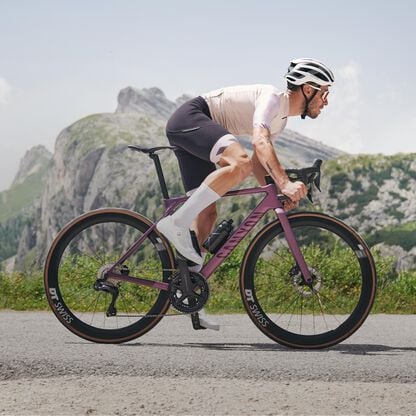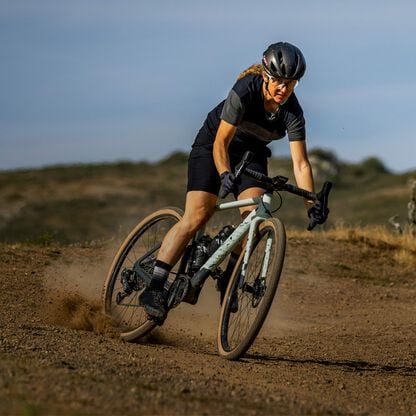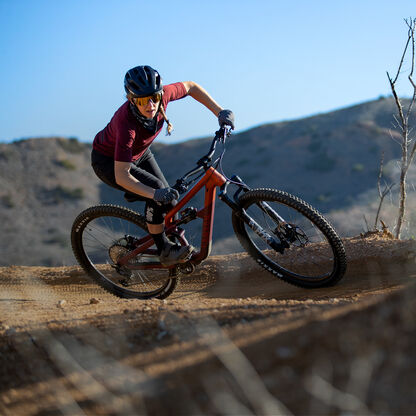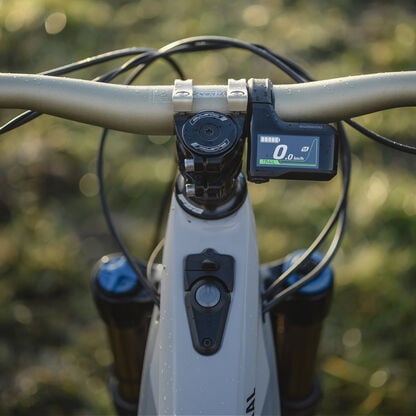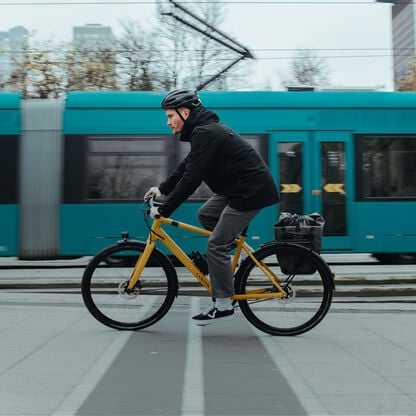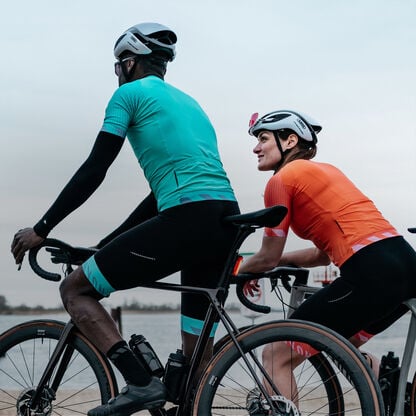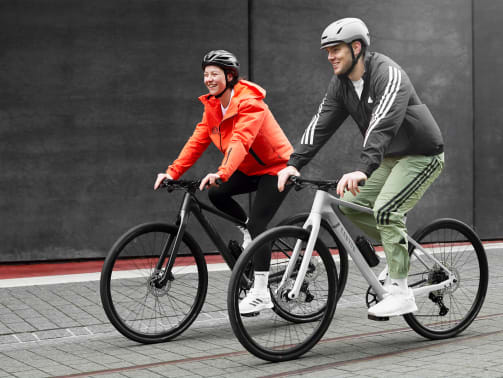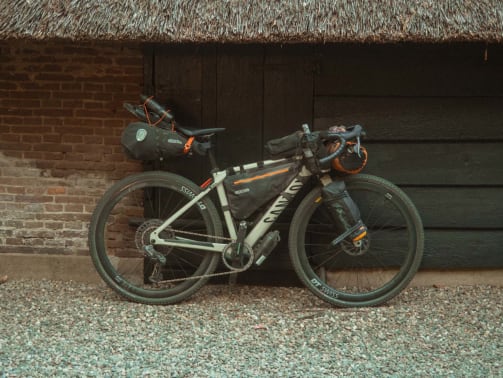How to choose the best touring bicycle for long distance adventures
If you dream of cycling adventures that take you all over the map, you have one very important first step to take: You need to choose the best bike for touring. Let’s explore how the right touring bicycle can be a game-changer for your next journey.
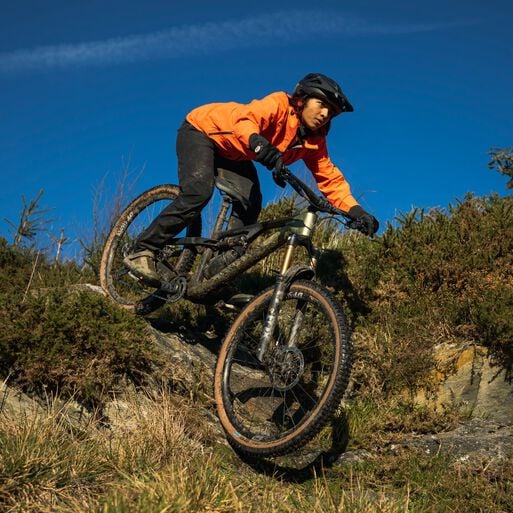

A great adventure always starts with the right companion. When it comes to exploring far and wide, choosing the best bike for touring is as important as mapping your route. If you’ve ever wondered what a touring bicycle is or how to pick one for epic journeys, you’re in the right place. Let’s break down your path to the perfect ride.
Contents
What is a touring bicycle?
A touring bicycle is specifically designed for carrying you and your gear comfortably over long distances regardless of where your route takes you- smooth asphalt, rugged gravel, and everything in between. The best bike for touring and long-distance riding prioritises comfort, endurance-focused geometry, and reliability over aerodynamic construction.
Long distance riding can mean anything from a full day ride in questionable terrain to a multi-day cycling adventure. Unlike a standard road bike, the touring bike is engineered for long hours in the saddle, carrying loads, and dealing with ever-changing terrain
Key characteristics of a good touring bike:
- Comfort-first geometry: Relaxed positioning minimises strain on hands, back, and shoulders.
- Endurance features: Wide tyre clearance, vibration-damping frame elements, and multiple hand positions for comfort on rough roads.
- Cargo capacity: Plenty of mounting points for water bottles, racks, and bags.
- Reliability: Durable components that hold up to repeated, extended use.
Whether you want the best bike for long distance adventure or a reliable bicycle touring machine, you’ll want a model that lives up to these standards.
Understanding bike types for touring and long-distance riding
Before you start narrowing down specifics like frame materials or suspension travel, it pays to know your main categories. Let’s look at the different types of bikes for touring or epic long-distance rides, so you can match your riding ambitions with the two wheeled machine of your dreams.
| Bike type | Best use | Key features | Canyon bikes for this |
|---|---|---|---|
| Road | Long days on paved roads, ultra-racing, or credit-card touring. | Endurance geometry, carbon or aluminum frames, tire clearance 28–35mm. | Endurace (multiple versions; carbon and aluminum). |
| Gravel | Riders seeking versatility for gravel, pavement, and bikepacking. | Massive tire clearance, robust frames, all the mounts | Grizl, Grail (in both carbon and aluminum) |
| MTB | Bikepacking and adventure touring on trails or wild country roads. | Tough frames, high-volume tires, wide-range gearing, multiple mounts. | Grand Canyon (multiple builds in both carbon and aluminum). |
| Hybrid | Urban commuting, beginners, or anyone who prizes comfort over out-and-out speed | Upright riding position, built-in accessories, versatile gearing | Pathlite:ONfly, Pathlite:ON SUV |
| E-bikes | Covering more ground with less fatigue, loaded touring, group rides with mixed fitness levels | Pedal-assist motors, large batteries, touring mounts | Endurace:ONfly, Grizl:ONfly, Pathlite:ONfly , etc. |
Once you’ve chosen your ideal setup, check out our guide on creating the perfect bikepacking route - it’ll help you plan your next adventure from start to finish.
How to choose the right touring bike based on your specific needs
Your touring bike should reflect the kind of journeys you dream about - whether it’s smooth tarmac, rugged gravel tracks, or a mix of both. The right choice can make every ride more efficient, comfortable, and fun, no matter how far you plan to go.
How do you choose the right touring bike for paved roads?
If you're dreaming of smooth tarmac, rolling countryside lanes, or continental crossing on national highways, then endurance road bikes would be your weapon of choice.
Endurance road bikes are perhaps the most popular choice for riders who want speed, but without sacrificing comfort. The geometry is relaxed compared to race bikes, offering wider tyre clearance (typically 28mm or more), along with features like vibration-damping seatposts and handlebars.
If you’d like to learn more about how geometry affects comfort and performance, check out our detailed road bike geometry guide.
How do I pick a touring bicycle for mixed terrain?
If your heart beats for diverse surfaces, washboard gravel, rural lanes, or even a bit of singletrack, but you also crave lightweight performance and speed, then a gravel bike is perfect for that. These bikes manage both speed and off-piste adventure, expanding what's possible on two wheels. Stable gravel bike geometry gives predictable handling on rough ground, while wider tire clearance (often 35-45mm or more) permits the use of chunky, grip-rich rubber.
These bikes shine for unsupported journeys - think wild camping, gravel road odysseys, and the freedom to chart your own course across open landscapes.
What if I want to tour off the beaten path?
For trail lovers, mountain bikes open up a universe of possible routes—forests, mountains, deserts, and challenging off-road tracks. It’s not just about technical singletrack, an MTB with all the mounts can easily be a go-anywhere touring rig. The suspension smooths out chatter, and wide tyres grip loose surfaces.
MTBs can be adapted with frame bags, panniers, and even dynamo lighting for proper wilderness adventure. They’re the ultimate choice for bikepacking trips far off the beaten track. Mountain bike geometry is designed for control and stability, featuring a slacker head angle, longer wheelbase, and wider handlebars - all of which help maintain balance on technical terrain and descents.
If you’d like to dive deeper into how geometry influences off-road performance, check out our mountain bike geometry guide.
What if comfort and practicality rule?
Is comfort your number-one priority or do you need a workhorse for city commutes plus occasional touring? Hybrid bikes can give you the perfect upright geometry with practical features: racks pre-installed, integrated lights, wide tyres for all surfaces, and weather-defeating mud guards.
Hybrids excel for riders who want one bike for everything, from groceries, work and weekend fun to longer tours through city and country. If you’re considering one as your do-it-all option, check out our hybrid bike buying guide to find the model that best fits your lifestyle and riding goals.
Are e-bikes good for long distance tours?
The best thing about e-bikes? They make the hills seem flat, extend your range, and help haul heavier loads with ease. Across the variety of e-bikes available at Canyon, you can go anywhere between 80-160km per charge depending on model and terrain.
E-bikes make long journeys more accessible for a wider range of riders, keeping the adventure spirit alive regardless of age, fitness, or destination. To help you choose the right model for your needs, check out our comprehensive e-bike buying guide.
Key features that define a great touring bicycle
If you’re wondering what makes good touring bikes truly excel over long distances, then it really is as simple as this - the bike needs to include some critical features designed for comfort, control, and reliable performance.
Frame materials and ride quality
Should you opt for carbon fibre or aluminium? Both materials deliver excellent long-distance performance, but with different advantages:
- Carbon fibre: Naturally absorbs road buzz, ultralight, used inhigh-end bikes (like the Endurace CF or Grizl CF).
- Aluminium: Robust and wallet-friendly, aluminium bikes offer strong performance and great value and are available in touring classics and entry-level versions (for example, Endurace AL or Grizl AL).
Canyon’s lineup offers both frame types across road, gravel, and mountain categories. As for whether carbon or aluminium frames are better for touring bicycles, it depends on your budget and what you value most: supreme comfort and weight savings (carbon), or practical performance and price (aluminium).
Wheel and tyre considerations
The right wheels and tyres can make any bicycle for long rides into a plush, competent traveller:
- Tyre width: At least 28mm for road, but 35-45mm boosts control and comfort off-road.
- Tyre pressure: Go lower for comfort; modern rims allow supple, lower pressures without speed loss. For detailed recommendations and setup tips, check out our tyre pressure guide.
- Wheel strength: Durable wheels are key—double-wall rims and heavier spokes handle rougher routes and heavier cargo.
Gearing for varied terrain
Your gearing can make or break your touring day:
- Wide range: A big cassette and compact crank help tackle steep hills, even as fatigue sets in.
- Climbing gears: Low gears are essential when you (and your panniers) face a wall of a hill.
- Simplicity: Fewer chainrings mean fewer issues on remote rides. But be sure your gear range matches your touring style.
Learn how bike gear ratios work in our detailed guide and find the ideal setup for your riding style. Whether you’re climbing steep hills or cruising on the flats, understanding your gears will help you ride more efficiently and choose the setup that best matches your goals.
Cargo mounts and accessories
The more mounting options your bike offers, the more tailored your tour can be:
- Bottle cages: Multiple mounts, even beneath the downtube, keep hydration within reach.
- Rack mounts: Both front and rear mounting points let you secure panniers, bags, and rack-top gear.
- Mudguard mounts: Mudguards save you from road spray and help keep gear (and yourself) cleaner.
Whether you need a best touring bicycle for around-the-world rambles or a good bike for local touring, these features define the genre. Models like the Canyon Endurace, Grizl, Pathlite, and Grand Canyon tick many, if not all, of these boxes for different adventures.
Want to dive deeper into finding the perfect setup for your next adventure? Take a look at our guide on choosing bikepacking bikes, and optimizing your gravel bike riding position.

How fit and comfort impact your long-distance experience
Even the best bicycle for long distance touring can only do so much if it doesn’t fit you properly. On epic rides, bike fit directly determines whether every mile brings joy - or aches and frustration. One hour may feel fine on a so-so setup, but after 100km, every detail matters.
Common fit issues that appear on long rides:
| Fit Issue | Description |
|---|---|
| Saddle height and angle | Incorrect setup can cause knee pain or loss of pedalling power. |
| Handlebar reach and drop | Too far of a reach or too low handlebars can cause neck, shoulder, and hand pain. |
| Cleat position | Off-centre or misaligned cleats can cause hot spots or numb feet. |
Comfort optimisation quick hits:
| Tip | Description |
|---|---|
| Multiple hand positions | Use drops, hoods, and tops to change grip often. |
| Saddle choice | Pick a saddle that matches your sit bone width and riding posture. |
| Clothing and accessories | Padded shorts, gloves, and moisture-wicking layers work wonders. |
Small adjustments can make a big difference on long rides. Take the time to fine-tune your fit and comfort setup—your body will thank you miles down the road.

How to train for long distance cycling?
While your touring bicycle is critical, training your body for endurance is just as important. Start by increasing ride duration gradually, adding back-to-back rides, and learning your fuelling and hydration needs. For a deep dive, check our full long-distance training guide.
Budget considerations for touring bicycles
Budget matters- not just for your bank account, but for how your bicycle stands up to years of adventure abuse. Here’s how pricing tiers typically break down:
- Entry-level: Affordable, reliable, perfect for new riders or light touring. (Canyon Endurace AL, Grand Canyon AL)
- Mid-range: Balanced performance and durability, for regular tourers who don’t want to skimp on comfort or features. (Canyon: Endurace CF, Grizl AL, Pathlite:ON)
- Pro-level: Top-end carbon frames and advanced components for ultimate performance and ultra-long adventures. (Canyon CFR models, Grail CF SLX, Endurace CF SLX)
Higher price points generally mean lighter bikes, greater comfort, and more cargo options, but entry and mid-range bikes are often every bit as capable for most riders. Ultimately, the right investment depends on your goals and how much you’ll actually use your bike for touring. If you’re looking for ways to make your adventures more affordable, check out our bikepacking on a budget guide - full of practical tips for saving money without compromising on experience.
Making your final decision: How to choose the perfect long distance bike
There are so many options out there. Here’s how you narrow it down:
- Riding style & terrain: Do you dream of smooth tarmac, mixed paths, or singletrack?
- Adventure goals: Weekend escapes, a single big tour, or round-the-world ambitions?
- Comfort priorities: Does fit, hand position, or all-weather performance matter most?
- Budget: What’s realistic for your wallet and commitment?
Explore our detailed buying guides for gravel, mountain, road and hybrid bikes, and make the most of your journey with Canyon’s bike comparison and bike finder tools.
Choosing the best touring bicycle is about matching a bike’s strengths to your dreams.
Now that you know how to find your next touring bike, go head out on an adventure.
Did this article help?
Thank you for your feedback
-
 About the author
About the authorVedangi Kulkarni
Discover the inspiring story of Vedangi Kulkarni, the youngest woman to cycle around the world solo and unsupported. This adventure-loving endurance athlete, public speaker, and writer is also a business owner and expedition manager. When she's not exploring the world, she's diving into philosophical and nature writing books or researching the Arctic.
